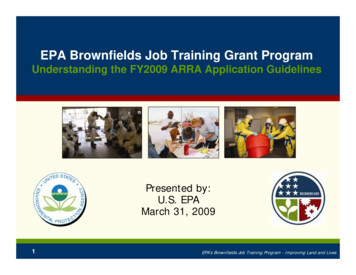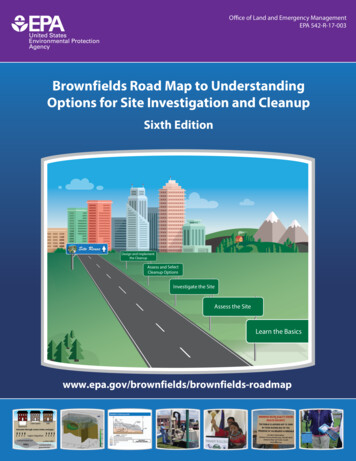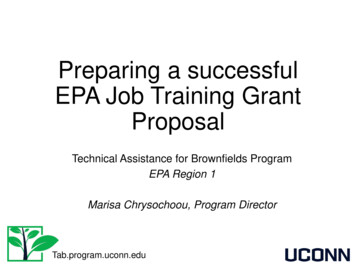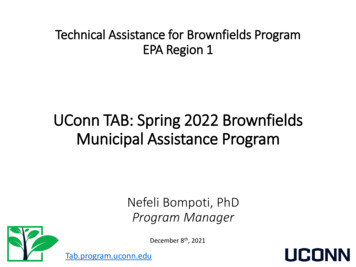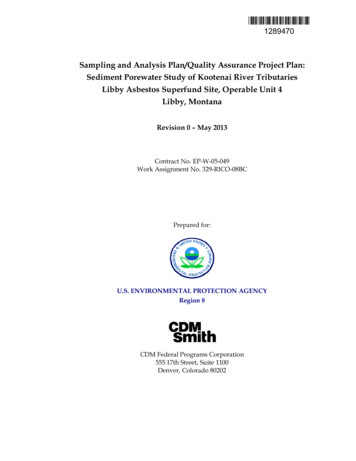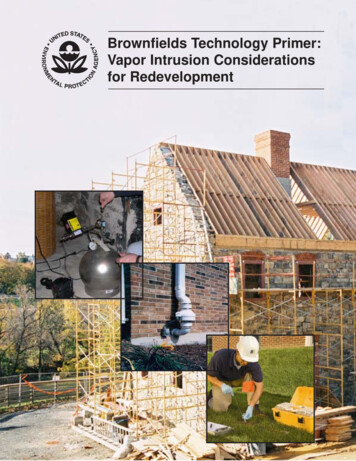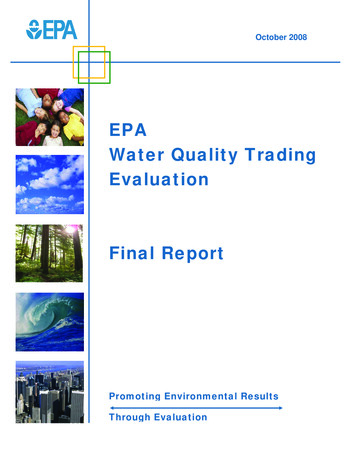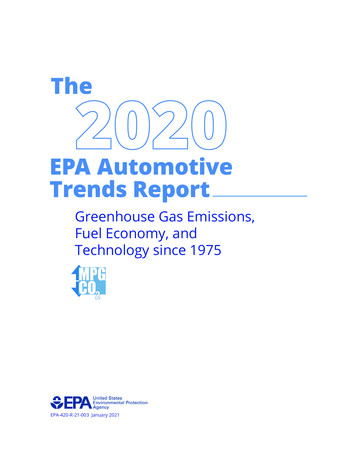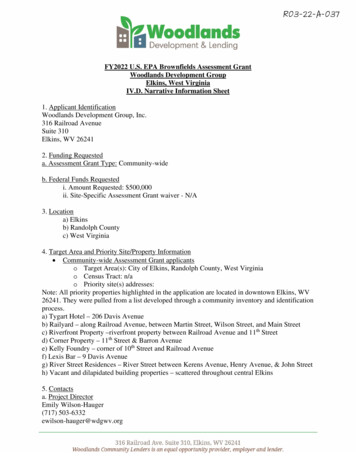
Transcription
FY2022 U.S. EPA Brownfields Assessment GrantWoodlands Development GroupElkins, West VirginiaIV.D. Narrative Information Sheet1. Applicant IdentificationWoodlands Development Group, Inc.316 Railroad AvenueSuite 310Elkins, WV 262412. Funding Requesteda. Assessment Grant Type: Community-wideb. Federal Funds Requestedi. Amount Requested: 500,000ii. Site-Specific Assessment Grant waiver - N/A3. Locationa) Elkinsb) Randolph Countyc) West Virginia4. Target Area and Priority Site/Property Information Community-wide Assessment Grant applicantso Target Area(s): City of Elkins, Randolph County, West Virginiao Census Tract: n/ao Priority site(s) addresses:Note: All priority properties highlighted in the application are located in downtown Elkins, WV26241. They were pulled from a list developed through a community inventory and identificationprocess.a) Tygart Hotel – 206 Davis Avenueb) Railyard – along Railroad Avenue, between Martin Street, Wilson Street, and Main Streetc) Riverfront Property –riverfront property between Railroad Avenue and 11th Streetd) Corner Property – 11th Street & Barron Avenuee) Kelly Foundry – corner of 10th Street and Railroad Avenuef) Lexis Bar – 9 Davis Avenueg) River Street Residences – River Street between Kerens Avenue, Henry Avenue, & John Streeth) Vacant and dilapidated building properties – scattered throughout central Elkins5. Contactsa. Project DirectorEmily Wilson-Hauger(717) 503-6332ewilson-hauger@wdgwv.org
316 Railroad Avenue, Suite 310Elkins, WV 26241b. Chief Executive/Highest Ranking Elected OfficialDave Clark, Executive Director(304) 404-2912dclark@wdgwv.org316 Railroad Avenue, Suite 310Elkins, WV 262416. Population of Target AreaElkins, West Virginia - 6,990 (U.S. Census Bureau, 2019)7. Other FactorsOther FactorsPage #Community population is 10,000 or less.1The applicant is, or will assist, a federally recognized Indian tribe or United Statesterritory.The priority brownfield site(s) is impacted by mine-scarred land.The priority site(s) is adjacent to a body of water (i.e. the border of the prioritysite(s) is contiguous or partially contiguous to the body of water, or would becontiguous or partially contiguous with a body of water but for a street, road, orother public thoroughfare separating them.)1, 2, 3The priority site(s) is in a federally designated flood plain.The reuse of the priority site(s) will facilitate renewable energy from wind, solar, orgeothermal energy; or will incorporate energy efficiency measures.430% or more of the overall project budget will be spent on eligible reuse planningactivities for priority brownfield site(s) within the target area.8The target area(s) is located within a community in which a coal-fired power planthas recently closed (2011 or later) or is closing.8. Letter from the State Environmental AuthorityPlease see attached letter from the West Virginia Department of Environmental Protection.9. Releasing Copies of Applicationsn/a
Office of Environmental Remediation601 57th Street SECharleston, WV 25304Phone: 304-926-0499Harold D. Ward, Cabinet Secretarydep.wv.govNovember 15, 2021Mr. David ClarkWoodlands Development Group316 Railroad Avenue, Suite 310Elkins, WV 26241RE:State Environmental Authority Acknowledgement LetterFY22 U.S. EPA Brownfields Assessment Grant ApplicationEPA-OLEM-OBLR-21-04Dear Mr. Clark,Thank you for your continued efforts to further enhance the state’s environment, economy, and quality oflife by applying for a U.S. EPA Brownfields Assessment Grant.I look forward to seeing future success as a result of environmental assessments performed on abandonedand underutilized properties in the City of Elkins with this grant. The Brownfields Assessment Grant willcontinue to build opportunities for redevelopment centering around the work the City of Elkins hasalready begun. The assessment and reuse planning for Elkins’ historic downtown and railyard, thecreation of a vibrant recreation economy, and addressing housing needs are vital to the WoodlandsDevelopment Group’s plans for the City of Elkins and surrounding areas. These combined efforts andvision will ultimately ensure continued development, investment, and revitalization in the region.As you prepare your application for this funding, the WVDEP Office of Environmental Remediation is infull support of your efforts. We are committed to assisting you to assess, remediate, and redevelopvacant, underutilized, and contaminated properties throughout the City of Elkins and surrounding serviceareas into productive and positive new uses. Please do not hesitate to contact me with any questions orneeds.Sincerely,Derek HancockWest Virginia Brownfields Coordinator
FY2022 U.S. EPA BROWNFIELDS ASSESSMENT GRANT NARRATIVEWOODLANDS DEVELOPMENT GROUPELKINS, WEST VIRGINIA1. PROJECT AREA DESCRIPTION AND PLANS FOR REVITALIZATIONa. Target Area and Brownfieldsi. Background and Description of Target AreaThe City of Elkins - the county seat of Randolph County, West Virginia (WV) - was incorporatedin 1890 and served as a hub for the West Virginia Central and Pittsburgh Railroad. The railroadserved not only as a conduit to export the natural resources from the region, but also in thedevelopment of the early city as a regional center for commerce and culture. Following World WarII and the subsequent transition in travel modes, as well as the decline in the region’s extractiveeconomy, both freight and passenger demands diminished. The last passenger train departed Elkinsin 1959, freight operations continued to dwindle, and the railyard and was closed in the late 1980s.The Tygart River also played a significant role in the early years of Elkins. City lots adjacent tothe river were reserved for industrial or railroad functions or were divided up as small residentiallots for employee-built housing. A flood control project was completed in the 1940s whichessentially eliminated community flooding, and development into southern Elkins quicklyfollowed. South Elkins was the location of many early industrial facilities that required the watersource for their operations including a brewery, foundry, and tannery.Today, Elkins serves as the regional center for commerce, health care, education, government, andprofessional services for a rural multi-county area. A growing medical campus is expanding onthe western margins of the old rail yard. Elkins is home to Davis & Elkins College (D&E), theAugusta Heritage Center/Festival, the Durbin and Greenbrier Scenic Railroad, and theMonongahela National Forest headquarters. Multiple ski resorts and state parks are within anhour’s drive. Elkins’ recreational and cultural tourism economy has grown in recent years, drawingover three million visitors annually to the region. The proposed EPA Brownfields funds will befocused on the historic Downtown, Railyard, and Riverfront area in Elkins.ii. Description of the Priority Brownfield Site(s)Elkins downtown brownfield sites includes a historic rail yard, mixed-use downtown buildings,residential neighborhoods, and stretch of riverfront that need significant assessment and reuseplanning before redevelopment efforts can commence. Addressing these environmentalcontamination concerns will allow Woodlands Development Group (Woodlands) and projectpartners, to attract the needed investment to the region to support a thriving, livable, equitable, andsustainable economy and community. Key properties prioritized for redevelopment by thecommunity include: Tygart Hotel - Woodlands acquired the historic Tygart Hotel, a former upscale downtown hotel.More recently, the Tygart was substandard rental housing, prior to Woodlands’ acquisition.Financing for this 16 million project will come from multiple public and private sources. TheTygart Hotel, however, still requires significant asbestos and lead-based paint (LBP)remediation planning and other environmental due diligence activities before construction. Railyard - The Elkins downtown railyard is owned by the Randolph County DevelopmentAuthority (RCDA). The property had/has the environmental risks typically associated withrailyards (e.g. heavy metals, arsenic, and PAHs) and has undergone prior assessment andremediation work which made it suitable for commercial reuse. RCDA is planning an eventspace and multi-use commercial facilities. However, given its high-priority and high-visibility,there is a strong desire to incorporate residential redevelopment which will require additionalassessment and reuse planning, and likely more remediation to meet residential standards.1
Riverfront – An active community group of stakeholders is continuing to plan for riverfrontproperty redevelopment to provide recreational opportunities, improved adjacent buildings, andriver access for residents and visitors. However, the property is suspect in areas where formerindustrials sites (e.g. dry cleaner, foundry, tannery), and potential fecal colloform are impactingthe land and water with known and unknow contaminants. Old Division of Highways road debrisalso litters a portion with potential VOCs, heavy metals, and PAHs. Corner of 11th & Baron Streets – This property, also owned by RCDA, includes a sanitationgarage site and has had a Phase I Environmental Site Assessment (ESA) completed. FurtherPhase II ESA sampling, remedial planning, and risk analysis is now required to transition theproperty for commercial use, which will capitalize on the site’s strategic location adjacent to thecounty industrial park property. Kelly Foundry - The former foundry provides multiple opportunities for property reuse alongthe city’s riverfront. The site has an ambiguous history of glass and plastics production, requiringa Phase I ESA, Phase II ESA, and remediation/redevelopment planning. Likely contaminantsinclude heavy metals, and potentially VOCs and SVOCs from cleaning of foundry molds. Lexis Bar - The former Lexis bar is a vacant/dilapidated building built in the 1920s. Havingserved in various capacities since then, the typical concerns regarding asbestos, LBP, and itsreported use as a former clandestine methamphetamine lab are cause for necessary Phase 1 andPhase 2 ESAs, with associated analyses of potential contaminants. River Street residences - There are multiple vacant/dilapidated residential properties spreadacross two city blocks targeted for redevelopment and reuse. Environmental conditions areunknown, and therefore, assessments will be needed to trigger the acquisition, demolition, andreuse to serve an area in need of affordable housing. Multiple Phase I ESAs will be needed, andlikely at least one Phase II ESA, along with asbestos, LBP, and meth lab inspections as theseproperties are targeted for acquisition for single-family rehabs and rebuilds. Additional vacant/dilapidated building properties have been identified in a communityproperty inventory initiative. Woodlands and the City of Elkins have committed resources todemolish priority dilapidated structures and reuse sites for housing development and green spacethrough their Property Rescue Initiative. As properties are identified, funds are needed to assessreuse options, environmental status, and (un)known contaminants. Most often a Phase I ESA,asbestos and LBP assessments, land surveys, building/infrastructure evaluations, and legal workare needed before designing, securing funding, and developing a site.b. Revitalization of the Target Areai. Reuse Strategy and Alignment with Revitalization PlansWoodlands, the City, RCDA, Elkins Main Street, and other community resident groups haveformalized a multi-pronged approach to redevelopment of the proposed brownfield sites: 1) TheCity’s Strategic Plan supports redevelopment of vacant and underutilized commercial/mixed-usestructures in the immediate downtown for new retail and hospitality venues for the growingrecreation and tourism economy. These priorities, including the Tygart Hotel redevelopment,railyard, and riverfront sites noted above (1.a.ii) are specifically targeted in the strategic plan. 2)Partners will prioritize dilapidated structures in adjacent neighborhoods for rehabilitation wherepossible, and for demolition and redevelopment where needed. This strategy is outlined in the 2018MOU between the City and Woodlands to address vacant/dilapidated structures. 3) The RiverfrontRedevelopment Plan includes several of the priority sites, and was jointly drafted by Woodlands,the City, riverfront building owners and businesses, local residents, and other community partners.The Plan includes cleanup of two industrial sites including the foundry, and rehabilitation of vacantcommercial buildings on the river with likely asbestos and LBP contamination.2
Recent planning surveys reinforce resident desire to rehab historic downtown buildings, diversifysmall businesses, develop the riverfront and railyard for recreation, and provide additionalaccessible housing – all reflected in the priority site reuse plans noted above (1.a.ii.) and otherrevitalization plans that include: Biking & hiking trails and green space, senior and affordablehousing, downtown housing, boutique hotel, event venue, river access, and revived storefronts.ii. Outcomes and Benefits of Reuse StrategyMuch of the proposed reuse strategies build upon the region’s growing recreational tourismmarket, and the corresponding need for workforce housing to support that market. This is asignificant transition for an Elkins economy historically based exclusively on resource extraction.A third-party market study recently completed for the proposed Tygart Hotel redevelopmentstated: “The area's flourishing reputation as an outdoor recreation travel destination has continuedto support growth in the market.” This is attainable in Elkins especially after utilizing EPABrownfields funding to address investor concerns about these catalytic sites. Redevelopment ofthe targeted sites will not only support the tourism industry, but Elkins residents’ well-being,equity, accessibility, and livability positively as well from improved housing options, additionalgreen space and recreation, and small business opportunities.c. Strategy for Leveraging Resourcesi. Resources Needed for Site ReuseAs a nonprofit community-based development organization, Woodlands has extensive experienceleveraging funding for (re)development of project sites. Woodlands currently has 11M in realestate assets that it owns and manages, totaling 26 separate properties. These held properties werefinanced with a variety of financing tools, including sources both public and private. Otherresources through partners are utilized as well. For example, under its MOU with the city,Woodlands utilizes city equipment and staff to demolish structures. The requested EPA assessmentand reuse planning funding will unlock additional millions of dollars in financial resources forproject implementation. Examples of resources that are secured or will be sought for reuse are: Tygart Hotel - New Markets Tax Credit program, Federal and State Historic Tax Credits,subsidized loans through CDFIs and WV Economic Development Authority. CongressionallyDirected Spending Request (earmark). Local investor pool. Railyard - Subsidized loan program through the CDFI Bond Program, administered by the U.S.Department of Treasury. U.S. Economic Development Administration grants. River Street Residences - HUD’s HOME-CHDO Program, Low Income Housing Tax Creditprogram (LIHTC), WV Property Rescue Initiative (PRI) subsidized loan fund.ii. Use of Existing InfrastructureAll the proposed priority sites are infill city lots with water and sewer infrastructure available. Themajority of identified sites also have access to stormwater conveyance, with the exception of theFoundry and the River Street residences. Additional public or private funding will be incorporatedinto project financing as needed for additional stormwater needs and onsite stormwatermanagement installations will be used as needed. All the properties are located on or near publicroadways. All the properties will therefore take advantage of existing public infrastructure.2. COMMUNITY NEED AND COMMUNITY ENGAGEMENTa. Community Needi. The Community’s Need for FundingSustainable growth in Elkins is hindered by the rural nature of the region, low tax base, and thegeneral lack of state funding for brownfields assessment & remediation. Both Elkins and WVgenerally rank at or near the top of measures of negative well-being, and at or near the bottom ofmeasures with a positive connotation. The city of Elkins lags in most measures of economic well3
being. Citizens grapple with lower-than-average household incomes and property values. Thepercentage of residents living below the poverty level is significantly higher within the city ofElkins than the surrounding area and the nation.Demographic And Economic DataTablePopulation1Poverty Rate2Per Capita Income3Median Household Income3Med. Property Value3Owner-Occupied Housing Unit Rate3ElkinsRandolph Co.West VirginiaUSA6,99023.2% 22,163 35,313 112,50053.7%28,69519.4% 24,162 41,094 99,20070.5%1,792,14716.0% 25,479 44,921115,00072.9%328,239,52310.5% 32,621 60,293 204,90063.8%1U.S. Census Bureau, PEP 2019 estimatesU.S. Census Bureau QuickFactsAmerican Community Survey, Five-Year Estimates 2014-201823Two census tracts in Randolph County are also designated as distressed areas by the AppalachianRegional Commission (ARC), one of them because it has a median family income of 41,786(56.5% of U.S. avg.), a poverty rate of 24.1% (171.8% of U.S. avg.) and is located in a countydesignated At-Risk in its classification system 1. In fact, a recent study commissioned by the ARCand completed by researchers at West Virginia University and the University of Tennesseedetermined that Randolph County’s significant dependence on the coal industry puts it at high-riskof further economic decline due to the declining trends of in-state and national coal markets 2.ii. Threats to Sensitive Populations(1) Health or Welfare of Sensitive PopulationsElkins and WV have a significant and growing elderly population over 65 years of age (20.5% and17.1% respectively), both higher than the nation 3. WV’s population includes a very highpercentage of lower income retirees, and according to the EPA’s EJSCREEN Tool, Elkinspopulation falls in the 75% percentile of low-income residents. According to the WV Kids CountData Book, WV was ranked 47th in the national for economic well-being in 2019. Additionally,the report found that 19.3% of Randolph County’s children live in poverty and 24.4% live inhouseholds with high housing cost burdens 4. Randolph County also has higher numbers ofnoninstitutionalized residents with disabilities than the nation 5. Senior citizens, residents, andvisitors with physical handicaps, children, pregnant mothers, and low-income residents are someof the highly sensitive and at-risk populations that are disproportionately impacted by brownfields.The proposed brownfields program is intended to provide equitable livability for the community.By identifying environmental hazards and planning for remediation, the brownfields funding willnot only mitigate or remove possible health risks, but it will also provide opportunities to improveconnectivity, accessibility (including American Disability Act improvements), energy efficiencyupgrades in buildings, between buildings and amenities, and in community facilities. Green space,trail, and sidewalk improvements will additionally improve well-being, recreational opportunities,and transportation alternatives for those sensitive populations as well.(2) Greater Than Normal Incidence of Disease and Adverse Health Conditions12345Source: American Community Survey, 5-Year Estimates 2015-2019West Virginia Kids Count. The State of Our Children: Data Book, 2019American Community Survey, 5-Year Estimates 2014-2018.4
Various sources characterize West Virginians as having a high incidence of obesity, diabetes, drugoverdose deaths, and disabilities that limit occupational abilities. WV, including Elkins, suffers ahigh rate of heart disease, cancer, and chronic lower respiratory diseases 6. According to PolicyMap, Elkins’ census tract 9661 where the priority projects are focused has highest possible LBPexposure risk ranking (10/10) 7. The EJSCREEN Tool finds the Lead Paint Indicator level forElkins in the 86% compared to the nation. The cause of this high exposure is likely due to the oldage of the housing/building stock. Specifically, 31.1% of houses in Elkins were built before 1939(as opposed to an average of 15.0% statewide). Also, over half of homes in Elkins were built whenasbestos was heavily used (1920s to early 1980s) 8, risking resident health when not properlyabated. Additional real and potential brownfields in Elkins pose significant health risks to residentsand tourists from industrial and railroad legacies, as well as the ecological health of the TygartRiver. Assessments and remediation planning leading to reuse will significantly improve publichealth by removing toxic and contaminated materials, improving connectivity and accessibilitybetween sites, providing healthy housing, utilizing alternative energy sources, and adding greenspace and recreational opportunities for better holistic well-being.(3) Promoting Environmental JusticeElkins central city area falls in the 95th percentile for lead paint exposure, 86th percentile forWastewater Discharge Indicator, 78th percentile for RMP (Risk Management Plan) proximity, and95th percentile for Hazardous Waste Proximity according to the EJSCREEN Tool 9. There are also3 PCS/ICIS listed water discharge reporting sites in the immediate area. Those considerationsalong with asbestos exposure, coal ash fill historically used for construction, unknowncontaminants in highway debris, and (un)known site-specific contamination (e.g. VOCs, PAHs,SVOCs, heavy metals, etc.) disproportionately impact low income and vulnerable populations thatlive in the area. Woodlands, as a Community Development Corporation, incorporates equitabledevelopment approaches and strategies into its work so that low income, racial and ethnic minority,and vulnerable populations can both participate and benefit from its services and projects. EPABrownfields funding will allow Woodlands the flexibility to better serve the area and encourageinvested participation from those most affected by contamination, dilapidation, and blight.b. Community Engagementi. Project Involvement & ii. Project RolesOrg/EntityPoint of ContactCity of ElkinsJessica Sutton, City Clerkjsutton@cityofelkinswv.com(304) 636-1414 ext.1211Randolph CountyRobbie Morris, Executive 304) 614-3268Elkins Main StreetMadelyn Humphrey, E.D.director.elkinsmainstreet@gmail.co(304) 940-9498Randolph CountyKaren Jacobson, Executive DirectorHousing Authoritykjacobson@rchawv.org(304) 636-6495 ext.166789Roles/InvolvementMOU to join resources/capacity to demolishdilapidated buildings and redevelop lots foraffordable housing. Identification of sites.Owner of at least 2 priority brownfieldsproperties. Redevelopment partner. Access toadditional resources.Community engagement. Relationships withproperty and business owners.Identification/prioritization of properties.Support site selection/prioritization.Development partner. Housing serviceprovider.Davis Medical Center. 2019 Community Needs Assessment, October 2019Policy Map. Rankings for Lead Exposure Risk. WSDOH, Vox Media, Policy Map, 2014-18.American Community Survey, 5-Year Estimates 2014-2018.https://ejscreen.epa.gov/mapper/5
Davis Health SystemTracy Fath, VP of DevelopmentDevelopment partner, service provider, essment. Property owner.(304) 637-3467WVU NorthernRay Moeller, Redevelopment Specialist Assist in identifying additional rovide technical assistance to downtownAssistance Center(304) 293-0390building owners.Public/Residents - community groups (e.g. Chamber, Rotary, volunteer committees, arts council, trail groups,etc.), business owners, lenders, developers, schools, churches – Provide community input on site prioritizationand reuse planning, receive reports/updates/plans, individual project planning/management.iii. Incorporating Community InputWoodlands will work closely with the aforementioned project partners to engage all stakeholdersand local community members, as well as regional and statewide partners. Communitystakeholders include but are not limited to community organizations and citizens groups,developers, property owners, health/human services groups, governmental entities, college, andlocal business owners/employers. Some statewide partners/stakeholders include the WVDepartment of Environmental Protection, WV State Historic Preservation Office, Department ofHealth and Human Services, WV Development Office, WV Division of Tourism, and WVCommunity Development Hub. Woodlands will provide regular written and social media posts,and presentations at partner meetings to provide updates as well as to address questions, concerns,and feedback. Additionally, Woodlands will utilize social media and local media outlets toannounce updates, significant milestones, and public meetings. This is appropriate because of therural population and tightly knit community. When needed - and as COVID-19 allows community meetings will be utilized to gather input on priority site identification, reuse planning,site visioning, and cleanup/reuse planning. Otherwise, virtual options for community engagementwill be utilized if public health concerns are high.3. TASK DESCRIPTIONS, COST ESTIMATES, AND MEASURING PROGRESSa. Description of Tasks/Activities and OutputsTask/Activity 1: Phase I & Phase II Environmental Site Assessmentsi. Project implementation: Woodlands will retain a Qualified Environmental Professional (QEP) through acompetitive procurement process to perform Phase I ESAs for selected, highest priority sites for redevelopment.Phase I ESAs will be performed in accordance with ASTM Standard E1527-13 and EPA All AppropriateInquiry Final Rule. Woodlands and partners have identified more than 2 dozen sites for potential Phase I ESAs.The selected QEP will also perform Phase II ESAs to determine the levels/extent of recognized environmentalconditions. Phase II ESAs will be conducted in accordance with ASTM E1903-11 as deemed necessary. Severalof these sites will require asbestos and/or lead-based paint (LBP) inspections. A Quality Assurance Project Plan(QAPP) and site-specific Sampling and Analysis Plans (SAPs), and Health and Safety Plans (HSPs) will beprepared and approved by EPA prior to performance of Phase II ESAs for an anticipated two sites and sitespecific SAPs will be prepared and approved by EPA prior to any kind of sampling.ii. Anticipated Project Schedule: Ongoing assessments throughout grant period; QEP will be procured in 1stquarter with Phase I ESAs beginning immediately on the highest priority sites, with focus on those anticipatedto require Phase II ESAs and other reuse planning studies. QAPP will be submitted to EPA for approval during2nd Quarter of the first year of the grant cycle, Phase II ESAs, site-specific SAP/HSPs anticipated during years2 and 3 of the grant cycle after initial priority Phase I ESAs are complete.iii. Task/Activity Lead: Woodlands Project Managers, Selected QEPiv. Outputs: Environmental firm selected; Executed contract with QEP with work plan and defined costs; atleast 8 Phase I ESAs, 6 asbestos and 6 LBP inspections; Updated ACRES database; 2 sites approved for PhaseII ESA investigation by EPA; Programmatic QAPP prepared and approved by EPA, 8 site-specific SAP/HSPs6
for Phase II, asbestos, and LBP investigations, 2 Phase II ESAs; Project planning meetings.Task/Activity 2: Target Community Stakeholder Outreach and Site Prioritizationi. Project implementation: Woodlands will lead outreach efforts and provide continued informationdissemination, gain additional and continued community support, and encourage continued participation as theindividual projects advance through assessment and reuse planning stages. Outreach activities will includeperiodic revisits and updates to site priority rankings, based on community input, project partners, andlocal/regional planning efforts. The QEP will be engaged to assist with a community kick-off meeting andparticipate in public meetings throughout the grant period. Other project-specific community meetings will beheld as needed. Communications material will be developed, as well as an outreach strategy.ii. Anticipated Project Schedule: Ongoing throughout grant periodiii. Task/Activity Lead: Woodlands Program Manager, QEP, supporting staff and program partnersiv. Outputs: 4 public meetings, 1 program overview document; annual blog/news update post; status/updatepresentations at public/organizational meetings; at least 1 article in local news outlet; list of recognized andpotential sites; 1 inventory creation and prioritization planning meeting; 10 potential eligible sites identifiedand prioritized during initial exploration phase; required EPA property approval for site eligibility.Task/Activity 3: Site Reuse & Remedial/Redevelopment Planningi. Project implementation: At least 4 high-priority sites will require significant redevelopment planning. Fourare currently identified and at least one more expected to be identified through the Phase II ESA process. AsPhase II ESAs are completed, the QEP will lead the development of cleanup and site reuse plans on at least 2sites. These plans will include the development of Analysis of Brownfield Cleanup Alternatives (ABCA)documents and associated estimated costs, as applicable. Additionally, it is anticipated that sever
creation of a vibrant recreation economy, and addressing housing needs are vital to the Woodlands Development Group's plans for the City of Elkins and surrounding areas. These combined efforts and vision will ultimately ensure continued development, investment, and revitalization in the region.
